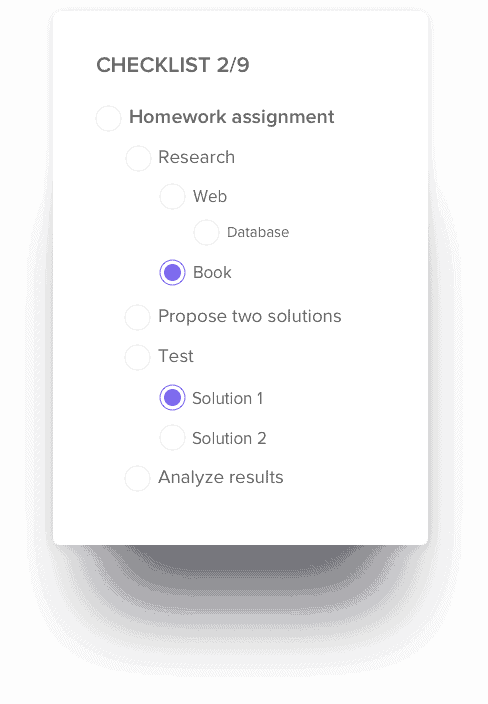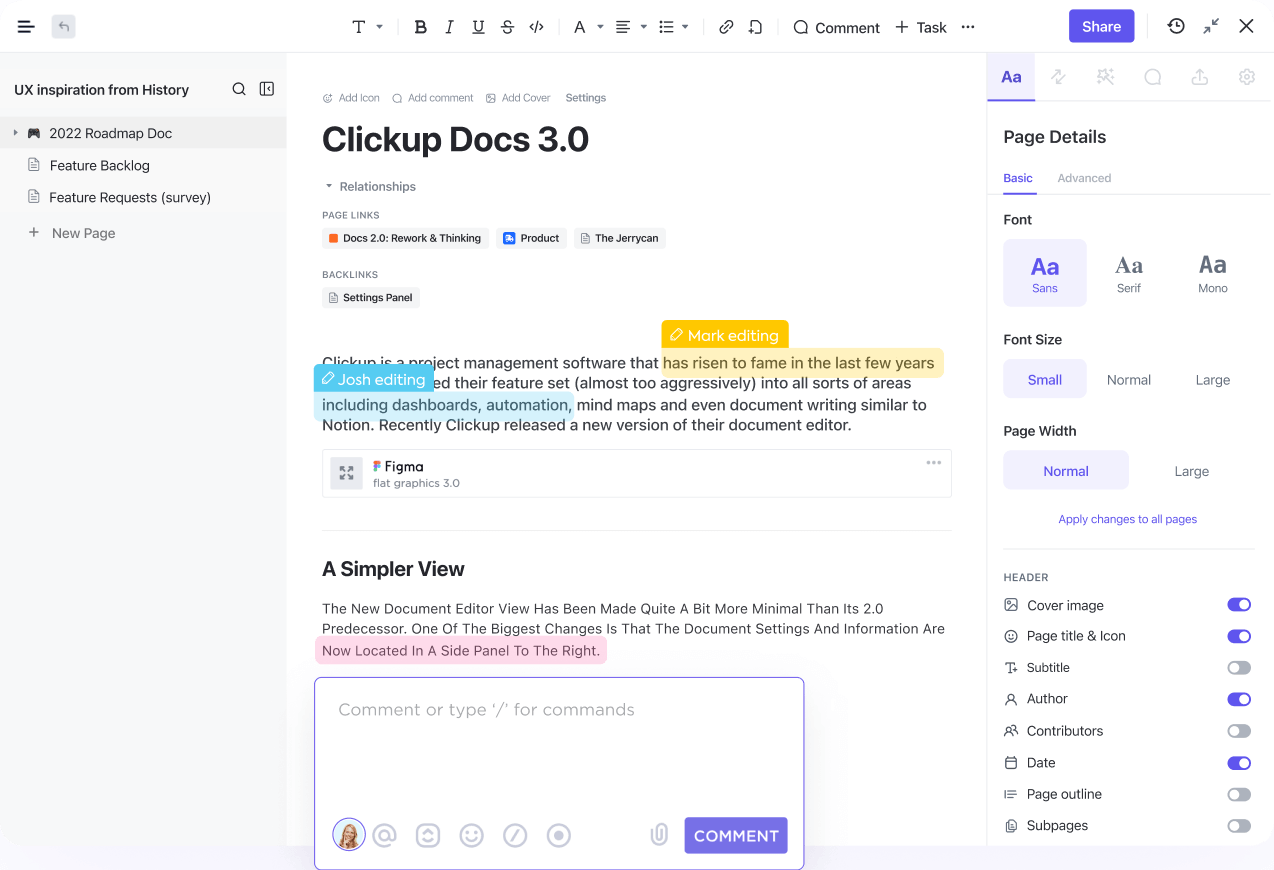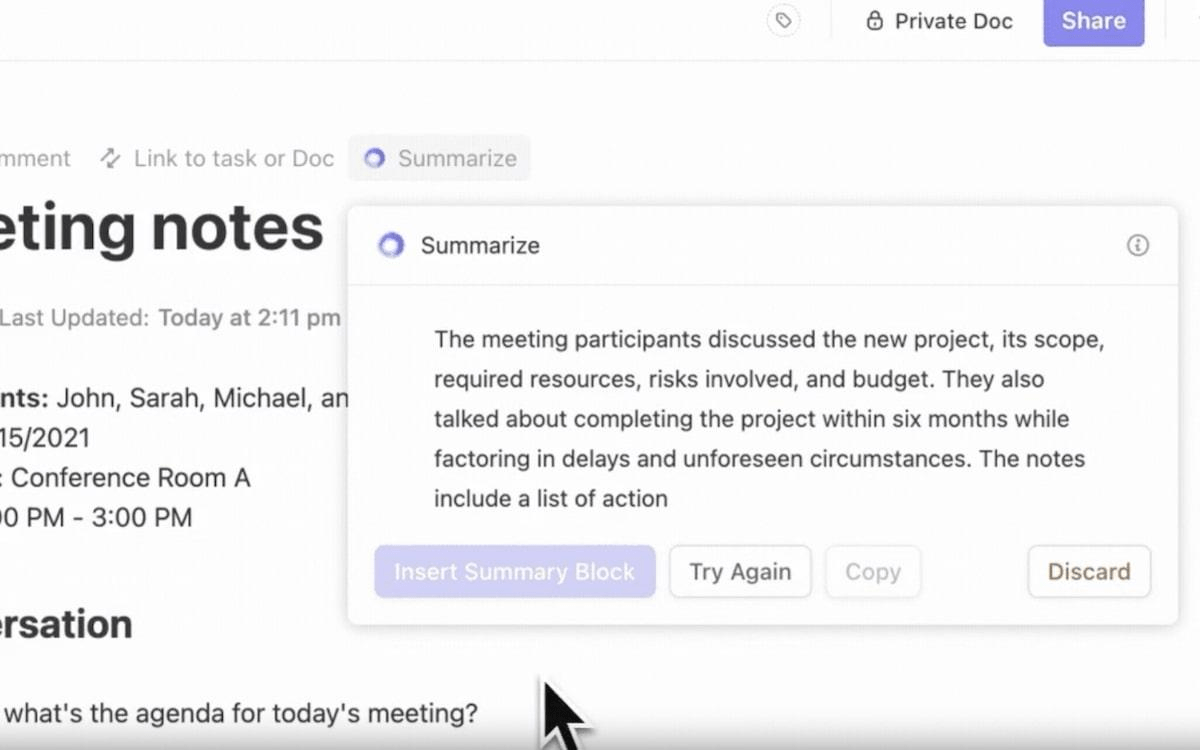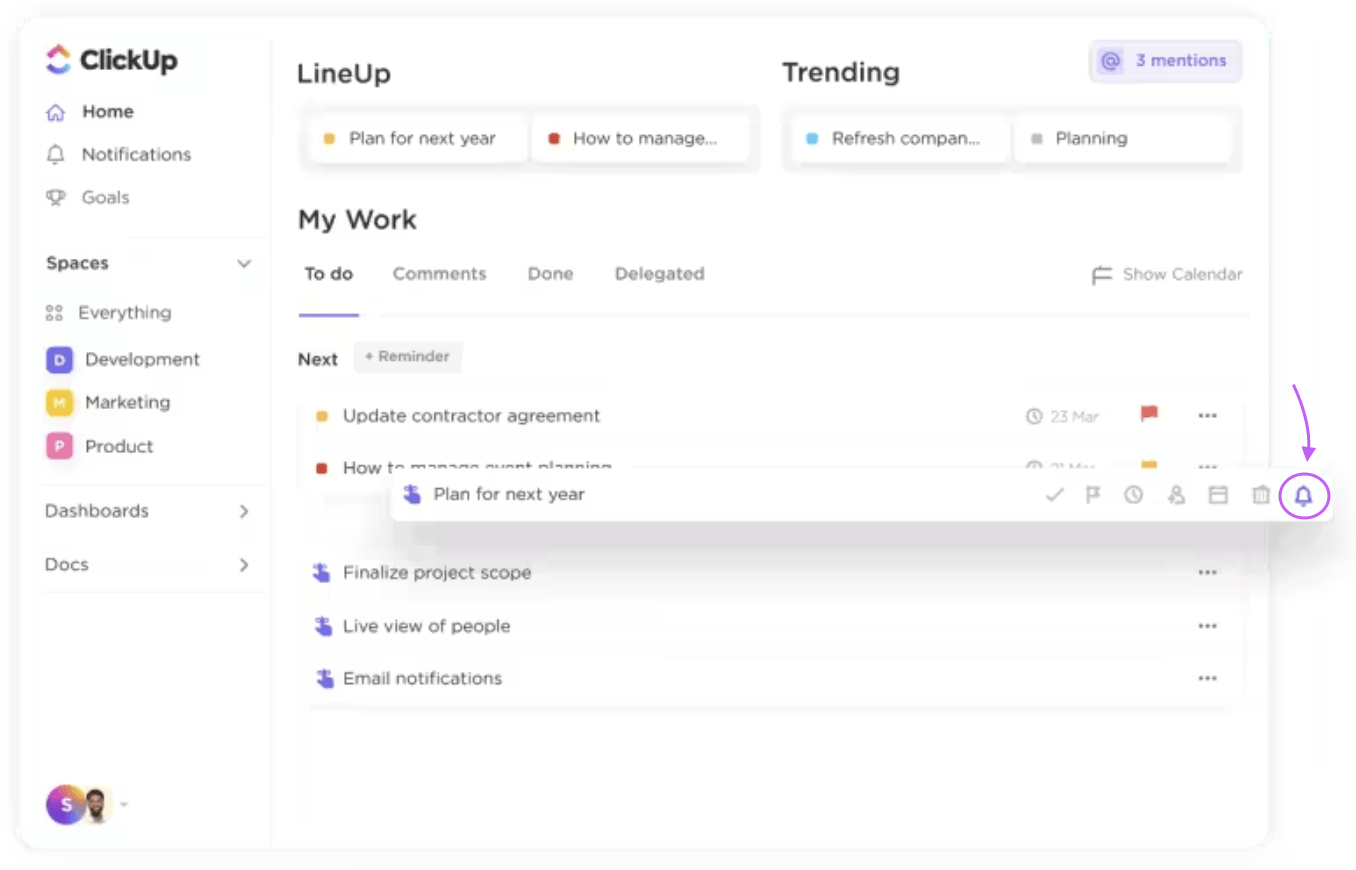How to Apply the PQRST Method for Effective Studying

Sorry, there were no results found for “”
Sorry, there were no results found for “”
Sorry, there were no results found for “”
You sit down to study, determined to absorb everything you need for the next big exam. An hour later, the textbook is still open on the same page, and your mind feels like a swirling cloud of information overload.
Frustrating, right?
The PQRST method might just be the solution you’re looking for. Short for Preview, Question, Read, Summarize, and Test, this study strategy helps you approach the material in a way that keeps you engaged and ensures better retention.
Let’s explore how it works and why it’s a valuable tool. 📑
📚Preview: Skim material to identify key concepts and create an overview. Use ClickUp Checklists or ClickUp Docs to organize headings, chapters, and embedded resources
📚Question: Turn headings into open-ended questions to spark curiosity. Brainstorm questions visually with ClickUp Whiteboards or record them in Checklists
📚Read: Dive into the material methodically, guided by your questions. Highlight key ideas, cluster related terms, and confirm understanding after each section
📚Summarize: Recap key points from memory to reinforce learning. Use ClickUp Brain for quick, AI-powered summaries or add notes directly to Docs or Checklists
📚Test: Assess understanding by answering your questions and identifying gaps. Use mnemonics or create quizzes for effective self-assessment
The PQRST method is a learning strategy that helps you better understand, retain, and recall information. It has five stages:
This method can dramatically improve learning and information retention through active interaction with your study material. It’s useful for everyone, including those who face challenges with memory or cognitive functions, such as those affected by prefrontal cortex damage.
Without a doubt, the PQRST method helps you absorb and retain information better than traditional learning methods. However, the method has its advantages and challenges, which are important to know before implementing it into your learning process.
Let’s see below. 👇
Here’s a breakdown of the major benefits:
While the PQRST study method has a lot going for it, let’s take a look at its limitations—and how you can work around them.
✨ To counter this, try starting with shorter and less complex learning material and gradually expand your limits as you get familiar
✨ You can tweak the method to suit your preferences and combine steps when needed. The key is to make it work for you, not to force yourself into a box
✨ You can still adapt it by focusing on reviewing key concepts and testing yourself on theory
✨ If you feel demotivated, build consistency by integrating it into a daily routine and devoting specific time slots to learning
PQRST involves a proven, structured framework that solidifies information retention and promotes active interaction with the study material.
We’ve curated a step-by-step guide to help you understand and implement this learning strategy with the ClickUp Student Project Management Software. This AI-powered learning management app offers tools and resources for managing learning materials, summarizing, and more.
In this stage, you skim through the study material and conduct cursory reading. You try to get a gist of what the material is all about.
Say you’re studying for your history exam on World War II.
In this stage, you’ll collect all your study materials (textbooks/notes), read the table of contents to find the key headings and subheadings related to WWII, get to those pages, and find highlighted events, concepts, visuals, and timelines.
But different materials need different preview approaches. Here are a few practical examples to preview effectively:
Remember, this is just the pre-reading phase, so all you need is a 10-15-minute glance at the key learning materials.
The Preview stage establishes a strong foundation for your study session and provides clear guidance on how to approach your learning. It forms the base to dive into detailed material with focus, ensuring that your efforts align perfectly with the course material you’ve chosen.
For example, ClickUp Checklists lets you quickly jot down important headings and chapters, turning them into a clear to-do list. As you work through the material later on, Checklists ensure nothing gets overlooked.

You can even nest similar topics, create sub-lists, and drag and drop list items to organize better.

If you prefer a more detailed approach to the preview process, try using ClickUp Docs to outline a clear structure with well-organized headings and subheadings.
Docs also lets you embed external resources, such as videos, articles, or PDFs, and collect all relevant study materials in one place.
Multiple people can edit and contribute to the document in real time, allowing you to jointly organize content, add notes, and create a perfect group learning experience.
In this phase, you’re required to convert headings and key concepts into open-ended questions. There are a few ways you can go about this:
When you convert a section into simple, easy-to-digest questions, you actively engage with the resource before you start the third phase.
This kind of engagement early on in your learning process excites your curious brain to find answers to your burning questions.
💡 Pro Tip: Don’t hesitate to iterate and re-iterate your questions as you re-read the material. If you come across any important points that your original questions didn’t answer, add them.
ClickUp Whiteboards are excellent for brainstorming and organizing questions visually on a digital platform.

Use sticky notes to list important questions, connect related topics, or plan out research areas.
📌 Example: World War II lasted six long years, and several events were interlinked. Using Whiteboards, you can link these events together, create a hierarchy, or drag and drop them to draw connections, roadmaps, or workflows.
💡 Pro Tip: In this phase, you can also use ClickUp Checklists and other checklist templates to note down questions. Once you find the answers, you can simply check them off.
During this phase, your goal is to have an in-depth, purposeful reading session. Here, you understand concepts and find answers to questions you came up with in the Question phase.
And guess what? Everything you did until now is going to assist you in this. But unlike normal reading, we are going to take a more structured and methodical approach.
Here’s how:
🔍 Did You Know? Adding colors to your text can help you find important information 70% faster and make it 39% more memorable.
This stage is also called the self-recite stage. Here, you summarize what you just read in order to check your understanding and retention of the material.
It’s highly crucial; do not skip it. It reinforces what you have learned while highlighting areas that may need further reading.
Here’s what you need to do:
If you’re short on time, use ClickUp Brain to summarize lengthy topics or complex jargon into simple, defined takeaways, reducing cognitive overload.
🧠 Know The Term: Cognitive overload is a point at which your brain becomes overwhelmed by new information and reduces learning efficiency.
Here’s how it works: you input raw text or content, and Brain will identify key points, extract essential information, and present them in a more digestible format. It’s the perfect AI note summarizer.

📖 Also Read: 10 Educational AI Tools for Students
The ‘Test phase’ is the final stage of the PQRST method. It serves as a self-assessment to evaluate your learnings to this point and identify areas for improvement.
Test yourself within 24 hours of reading the material to avoid forgetting it.
Let’s see how you can go about it.
🔍 Did You Know? Using mnemonic devices or memory aids like acronyms, rhymes, songs, or images—simplify and retain challenging information. For example, ‘My Very Educated Mother Just Served Us Nachos’ helps recall the order of planets: Mercury, Venus, Earth, Mars, Jupiter, and so on.
If you want to make things efficient, the ClickUp Student Template is a good starting point.
This template makes it easy to organize coursework and lectures, categorize subjects, and manage assignments with clear, actionable tasks. Pairing it with the PQRST method can boost study efficiency and keep you focused.
Start with a list of upcoming topics or chapters to review, setting the stage for focused studying. Formulate guiding questions during your preview and add them as tasks in ClickUp. While reading, take organized notes in ClickUp, breaking them into subtasks for specific sections or topics. Summarize key points in comments or summary tasks to reinforce your understanding.
Using this template alongside the PQRST method creates a structured, stress-free study plan that improves learning and retention.
⚡ Template Archive: Cornell notes are a tried-and-true method for organizing information effectively. Explore Cornell note templates that provide a structured format for efficiently summarizing, reviewing, and retaining knowledge.
ClickUp Reminders allows you to set automatic alerts for important study milestones, deadlines, and tasks. With Reminders, you get access to:

Next, ClickUp Calendar View offers an organized way to track and manage your study sessions. You can schedule sessions, set due dates, and view them in daily, weekly, or monthly formats—from a single window.

Syncing with external calendars like Google or Outlook helps students integrate all their commitments in one place, ensuring study sessions align with other important events.
This is the special advantage of ClickUp: offering most of the tools needed for organizing the projects in one place. It doesn’t only allow the managing and assignment but also offers other tools in the same environment such as Documents, where one can take notes and make reports, and integration with calendar and emails, all in one place.
📖 Also Read: 6 Free KWL Templates and Resources for Teachers
The PQRST method is highly adaptable. Here are a few tips on how to tweak PQRST for different scenarios, along with examples:
The PQRST method isn’t just a study tool—it’s a versatile approach that can adapt to different learning scenarios. Whether you’re reviewing textbooks, preparing for exams, or organizing lecture notes, this method helps you break down information into manageable steps.
Let’s explore where it works best. 📋
As a student, you’re likely juggling multiple subjects, assignments, and deadlines. It’s easy to feel overwhelmed by the sheer amount of information you need to absorb.
However, the PQRST study method can help break everything down into manageable, efficient steps. Here’s how you can use it:
Let’s say you’re in a marketing role and need to learn how to use a new customer relationship management (CRM) tool.
Here’s how you can apply PQRST:
The PQRST method works equally well in the personal sphere and can help you achieve personal development goals.
You can make use of it for anything, from picking up a new hobby and learning a language to diving into personal development books. It will help you retain what you learn and apply it in your daily life.
Let’s say you’re studying Spanish. Here’s how you can apply PQRST:
📖 Also Read: 10 SMART Goals for College Students
The PQRST method is quite effective. But there are some things you can do to make it even more powerful. See below. 👀
Before jumping into the PQRST method, define clear learning goals for your study session:
When you set specific objectives, you guide your study sessions in a way that makes the PQRST method more focused and efficient.
Consider the main concepts or terms in the material and turn them into questions that challenge your understanding.
For example, when reading about the human circulatory system, a good question would be: ‘What role does the heart play in blood circulation?’
This kind of inquiry encourages you to think critically about the content rather than just absorbing it passively. The more specific your questions, the more likely you are to engage with the material meaningfully.
Instead of simply rereading the material or highlighting sections, take a moment to put the concepts into a brief, coherent summary.
When you explain the material to yourself in a simplified form, you’re forcing your brain to process the information more thoroughly.
Active recalling means retrieving the information from memory without looking at your notes. This memorization technique involves writing down everything you remember about a topic or using flashcards.
For example, if you studied the circulatory system, close your notes and write down everything you can remember about how blood circulates through the body. You might even draw an image to represent it visually.
💡 Pro Tip: To combat severe memory deficits, try using spaced repetition combined with active recall. This technique involves reviewing information at increasing intervals over time, which strengthens long-term retention.
Ultimately, take time to review and reflect on what you’ve learned. This step might involve going over your summaries, reviewing your notes, and testing yourself again.
Reflecting on how well you understood the material and where you may need further clarification ensures that the material stays fresh in your mind. For example, after completing a chapter, go back a day later and test yourself again on key concepts to see if they’ve stuck.
💡 Pro Tip: Remember to space out your review sessions in a balanced way. You don’t want to do it so soon that there’s no possibility of you forgetting anything or so late that you forget everything.
Here are some common mistakes to avoid when using the PQRST method:
It might seem like a waste of time, but previewing the material is essential because it gives you an overview of what to expect.
If you jump straight into reading without knowing the structure or the main topics, you’ll likely miss important connections and context.
Just reading the material doesn’t guarantee that you’ll retain information. You need to be actively engaged during the ‘Read’ phase.
This means paying attention to the material while answering the questions you’ve formulated. Skim the chapter actively, focusing on answering your specific questions. Don’t just let the text wash over you—actively process the information.
A common mistake with the PQRST method is not testing yourself enough, which can seriously limit how well you understand and retain the material. When you finish reading and summarizing, don’t just glance over your notes and assume you understand everything.
Testing is the only way to verify whether you’ve truly internalized the information.
Whether through flashcards, practice questions, or even teaching the material to someone else, ensure you test your knowledge thoroughly.
📖 Also Read: How to Use the Chunking Method to Improve Memory
The PQRST method enhances learning by promoting active engagement with the material, improving retention, and fostering critical thinking. Whether you’re a visual learner or prefer self-testing, the PQRST method helps you break down complex concepts into manageable steps.
To streamline your study sessions and stay organized, try using ClickUp to manage tasks, set reminders, and track progress throughout each stage of the learning process.
Sign up for free today!
© 2026 ClickUp